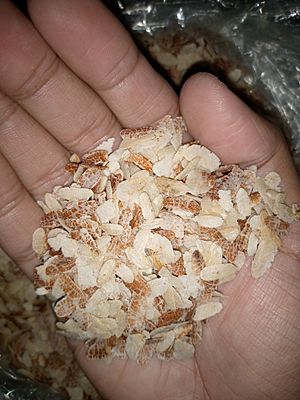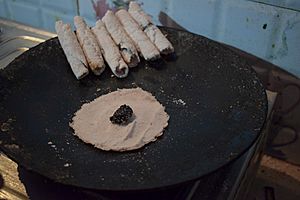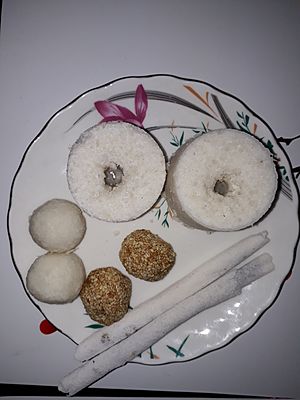Jolpan facts for kids
Jolpan (pronounced "jol-pon") are yummy snacks often eaten for breakfast in Assam, a state in India. You might also find them served at special Bihu festivals or during weddings!
The word jolpan actually means "water and betel leaf," but it's used for all sorts of snacks. These snacks include different types of rice dishes, flat cakes called pitha, sweet balls called laru, and of course, tea. Other common breakfast items like roti (flatbread), luchi (fried bread), and paratha (layered flatbread) can also be part of jolpan.
Contents
Types of Jolpan
Jolpan comes in many delicious forms! Some popular types are Bora saul, Komal Saul, Xandoh, Chira, Muri, and Akhoi. These are often served with curd, jaggery (a type of unrefined sugar), or other tasty additions.
Bora Saul
Bora saul is a special kind of sticky rice. It's usually boiled and then served as jolpan. People often eat it with curd (like yogurt), milk, jaggery, or sugar. This type of jolpan is very popular in Northern Assam.
Komal Saul
Kumol saul is a unique rice from Assam that doesn't need cooking! It becomes soft and ready to eat just by soaking it in water for a short time. After soaking for about fifteen minutes in warm water, you can enjoy it with milk or curd, jaggery, or yogurt. It's super easy and quick!
Chira
Chira is also called flattened rice or beaten rice. It's made by de-husking rice and then pressing it into thin, dry flakes. When you add these flakes to a liquid like water, milk, or curd, they swell up and become soft. You can eat chira raw by soaking it, adding salt or sugar, or even lightly frying it in oil.
Muri
Muri is puffed rice. It's made by heating sand in a pot and then adding rice grains. The rice puffs up, and then it's separated from the sand using a strainer. Sometimes, the rice is washed in salty water to give it extra flavor. Muri is often served with hot milk or curd and jaggery or sugar.
Xandoh Guri
Xandoh Guri is made from special types of Bora saul rice. First, the rice is soaked for three to four days. Then, it's fried. The fried rice is pounded using a dheki, which is a traditional wooden mill used in Assam to pound grains. After pounding, it's sifted to remove the husks. Finally, this pounded and de-husked rice is fried again in hot sand to make Hurum. It's served with curd, hot milk, yogurt, sugar, or jaggery.
Sunga Saul
To make Sunga saul, de-husked Aroi bora saul (a type of rice) is soaked for a few hours. Then, it's placed inside a young bamboo tube, and a little water or sometimes coconut milk is added. A Banana leaf is used to seal the tube like a cork. The bamboo tube is then roasted over a fire. Once cooked, the tube is removed, leaving a solid cylinder of rice. This is served with curd, hot milk, yogurt, or sugar.
Pithaguri
Rice flour, called Pithaguri in Assamese, is fried and served with hot milk, jaggery, and sometimes with ripe banana or ripe jackfruit. It's a very common type of jolpan.
Suji
Suji (Semolina) is another popular type of jolpan, often enjoyed as a dessert. Like pithaguri, it's heated in a frying pan. Water is then added to make it into a paste, and it's served with hot milk.
Koni-dhan
Koni-dhan means "tiny rice" in Assamese, and it refers to millet. To prepare it, the millet is washed and then toasted until it smells nice. Then, boiling water (five parts water for every two parts millet) is added along with some sugar or salt. The mixture is cooked covered on a low flame for about 30–35 minutes.
Pitha
Pitha (pronounced "pee-tha") are like rice cakes or pancakes. They are thin, flat cakes made from a batter and cooked on a hot pan. Pitha are a very important part of jolpan in Assam. They are usually made for special events like Bihu festivals. Pitha are typically made from soaked and ground rice. They can be fried in oil, roasted over a slow fire, or baked. Some popular types of pitha include Til Pitha, Narikol Pitha, Ghila Pitha, Sunga Pitha, and Tekeli Pitha.
Kachi Pitha
Kachi Pitha is a type of pancake often made for special occasions like Bihu. It's made from Bora saul (a sticky rice) that is soaked and ground. This rice flour is then baked and filled with sesame seeds, ground coconut, dried orange peel, and jaggery. It's then pressed and rolled into many layers.
Ghila Pitha
Ghila pitha is a type of pancake named for its shape, which looks like a knee cap. In Assamese, "knee cap" is Ghila. It's made from the flour of Bora saul or other common rice. A paste is made from rice flour and jaggery, then fried in cooking oil. Sometimes, salt is used instead of jaggery to make a savory Ghila pitha. It's commonly prepared and served during Bihu festivals.
Sunga Pitha
Making Sunga Pitha is similar to making Sunga Saul, but it uses ground rice or rice flour instead of whole rice. Rice flour from Xaali saul and Bora saul is mixed with water and jaggery and stirred well. This paste is then put into a young bamboo tube, sealed with a banana leaf, and roasted over a fire. Once cooked, the bamboo tube is removed, leaving a solid cylinder of pitha. This is cut into pieces and served with hot milk.
Uhuwa Pitha
For Uhuwa Pitha, rice flour from xaali saul and bora saul is mixed with jaggery or salt and water, then stirred thoroughly. The paste is rolled into small balls, flattened, and then boiled in water. It's served with tea and can also be eaten with milk.
Tekeli Pitha
To make Tekeli Pitha, rice flour from Xaali saul (sun-dried rice) and Bora saul is mixed with coconut, sugar, and a little powdered milk. Ground cardamom and dried orange peel can also be added. An earthenware pot, half-filled with water, is placed on a hearth. A clean cloth is put over the opening of the pot, and the flour mixture is placed on it. The opening is then covered with a cork, and a fire is lit under the pot. The mixture bakes from the vapor coming from inside the pot and takes shape. It's then cut into pieces like a cake and served with tea. This pitha is named Tekeli Pitha because a tekeli (earthenware pot) is used to make it.
Ketli Pitha
Ketli Pitha is made in the same way as tekeli pitha, but a kettle is used instead of an earthenware pot. That's why it's called Ketli pitha (Ketli means kettle in Assamese). The kettle's lid is placed upside down on the kettle, and the mixture is put on it. It usually bakes faster than tekeli pitha.
Laru
Different kinds of laru (sweet balls) are made during the Bihu season in Assam.
Narikol'or Laru
To make Narikol Laru, mature coconut is grated (or ground) and fried. Then, sugar is added and mixed well. This mixture is toasted over a low fire until the ingredients become sticky and hold together. To check if it's ready, a small ball is formed. If it holds its shape, the caramelized coconut is taken off the heat to cool slightly. Before it cools completely, small balls are rolled with hands rubbed in cold water and set aside to dry. These coconut balls are served with tea.
Tilor Laru
Tilor laru is a type of sesame candy. Sesame seeds are fried and set aside. Jaggery is heated until it melts, then poured over the fried sesame seeds. The mixture becomes sticky, and small balls are rolled and set aside to dry. These sesame balls are also served with tea.
Tea
A cup of tea is always served with jolpan or pitha. You'll always see them together! Tea is served in many forms, like Black tea, Milk tea, Spiced tea, or Lemon tea (black tea with lemon juice). Tea is a very popular beverage in Assam and can also be thought of as a type of dessert.





